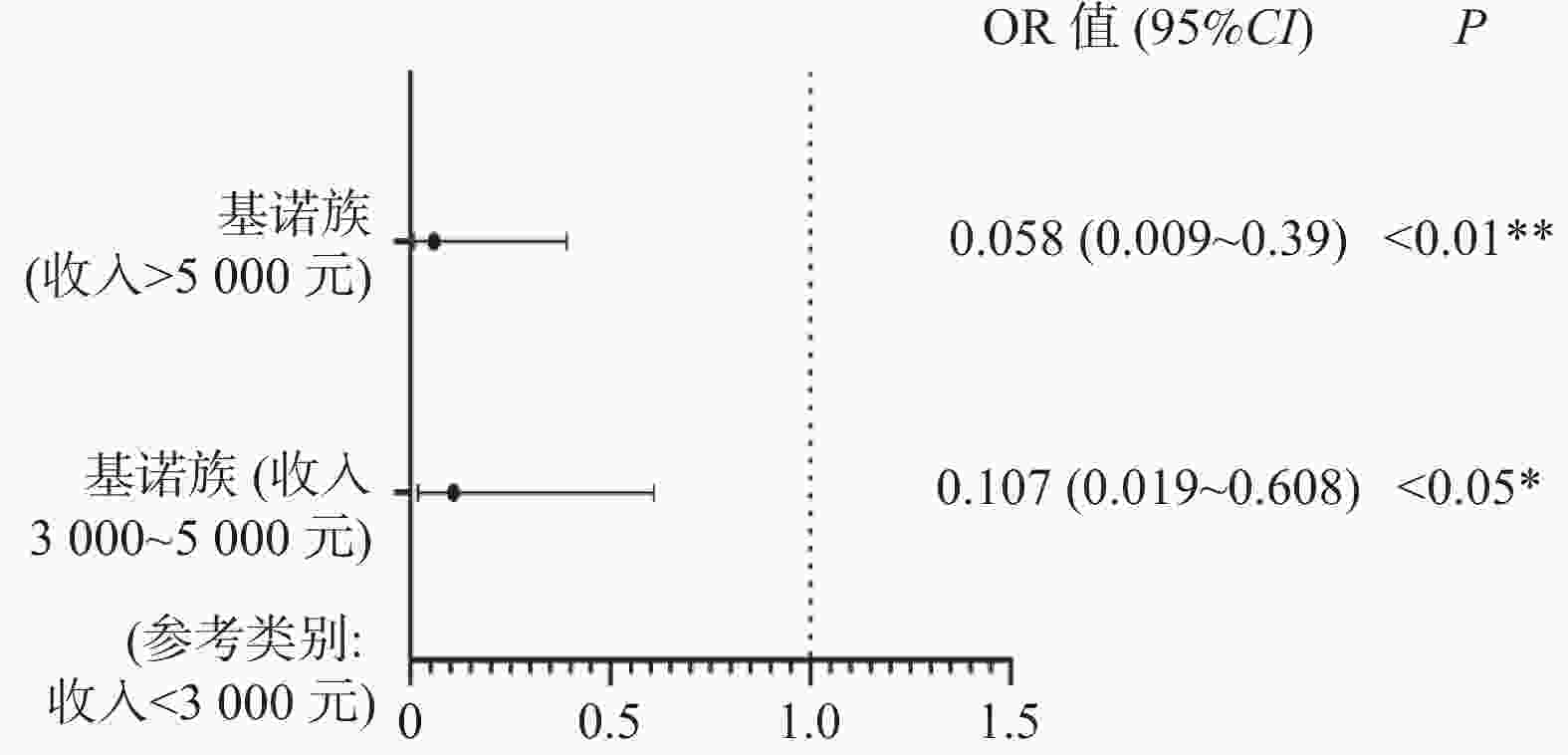Depression Symptoms and Influencing Factors among Youth in Eight Indigenous Minority Groups in Yunnan Province
-
摘要:
目的 了解云南省少数民族青年抑郁症状发生情况及其影响因素,为不同民族青年群体的心理健康促进提供依据。 方法 采取分层随机抽样,运用9项患者健康问卷,对云南省3个州(市)8个世居少数民族的15~44岁青年进行调查。 结果 在纳入分析的1145名少数民族青年中,抑郁症状检出率为17.29%,经性别标化后,佤族(14.18%)和怒族(11.04%)抑郁症状检出率较高。睡眠障碍是5个少数民族出现抑郁症状的共有危险因素(P < 0.05);基诺族女性出现抑郁症状的可能性是男性的9.245倍(95%CI:1.062~54.002);傈僳族的慢性病患者出现抑郁症状的可能性是未患病者的5.796倍(95%CI:1.684~19.944)(P < 0.01)。 结论 云南省8个世居少数民族青年的抑郁症状发生情况和影响因素存在民族差异,未来宜针对不同民族的特有情况精准施策。 Abstract:Objective To understand the occurrence of depression symptoms and its influencing factors among youth in eight indigenous ethnic minority groups in Yunnan Province, in order to provide a basis for promoting the psychological health of different ethnic youth groups. Methods By stratified random sampling, 9 patient health questionnaires were used to investigate 15~44 years old young people from eight ethnic minorities in three prefectures (cities) of Yunnan Province. Results Among the 1145 minority youth included in the analysis, the detection rate of depressive symptoms was 17.29%. After gender standardization, the Wa (14.18%) and Nu (11.04%) ethnic groups had higher rates of depressive symptoms. Sleep disorder was a common risk factor for depressive symptoms among five ethnic groups (P < 0.05). The likelihood of depressive symptoms in female Jinuo individuals was 9.245 times higher than in males (95% CI: 1.062-54.002). Patients with chronic diseases in the Lisu ethnic groups were 5.796 times (95% CI: 1.684~19.944)(P < 0.01) more likely to have depressive symptoms than those without the disease. Conclusion The occurrence and influencing factors of depression symptoms among the youth of eight indigenous minority groups in Yunnan Province vary among ethnic groups, and targeted policies should be implemented according to the unique situations of different ethnic groups. -
Key words:
- Ethnic minorities /
- Mental health /
- Depressive symptoms
-
表 1 被调查对象的人口学特征[n(%)]
Table 1. Demographic characteristics of the respondents [n(%)]
变量 总人数
n= 1145佤族
n = 148傈僳族
n = 160怒族
n = 154基诺族
n = 160拉祜族
n = 128布朗族
n = 138哈尼族
n = 155傣族
n = 102χ2 P 年龄(岁) 20.564 0.113 15~25 295(25.76) 40(27.03) 39(24.38) 43(27.92) 33(20.63) 45(35.16) 39(28.26) 31(20.00) 25(24.51) 26~35 370(32.31) 43(29.05) 51(31.88) 44(28.57) 54(33.75) 35(27.34) 56(40.58) 56(36.13) 31(30.39) 36~44 480(41.92) 65(43.92) 70(43.75) 67(43.51) 73(45.63) 48(37.50) 43(31.16) 68(43.87) 46(45.10) 性别 7.343 0.394 男 575(50.22) 69(46.62) 87(54.38) 83(53.90) 75(46.88) 56(43.75) 69(50.00) 86(55.48) 50(49.02) 女 570(49.78) 79(53.38) 73(45.63) 71(46.10) 85(53.13) 72(56.25) 69(50.00) 69(44.52) 52(50.98) 婚姻状况 8.195 0.316 在婚 706(61.66) 88(59.45) 74(46.25) 100(64.94) 104(65.00) 83(64.84) 80(57.97) 98(63.23) 67(65.69) 不在婚 439(38.34) 60(40.54) 86(53.75) 54(35.06) 56(35.00) 45(35.16) 58(42.03) 57(36.77) 35(34.31) 受教育程度 295.001 < 0.001** 文盲 128(11.18) 4(2.70) 35(21.88) 14(9.09) 4(2.50) 12(9.38) 53(38.41) 4(2.58) 2(1.96) 小学 332(29.00) 69(46.62) 63(39.38) 41(26.62) 3(1.88) 49(38.28) 44(31.88) 35(22.58) 28(27.45) 初中及以上 685(59.83) 75(50.68) 62(38.75) 99(64.29) 153(95.63) 67(52.34) 41(29.71) 116(74.84) 72(70.59) 职业 157.017 < 0.001** 工人 124(10.83) 13(8.78) 53(33.13) 21(13.64) 13(8.13) 9(7.03) 5(3.62) 3(1.94) 7(6.86) 农民 610(53.28) 90(60.81) 38(23.75) 75(48.70) 80(50.00) 72(56.25) 97(70.29) 109(70.32) 49(48.04) 其他 411(35.90) 45(30.41) 69(43.13) 58(37.66) 67(41.88) 47(36.72) 36(26.09) 43(27.74) 46(45.10) 家庭月收入(元) 18.806 < 0.001** < 3000 539(47.04) 67(45.27) 98(61.25) 78(50.65) 23(14.38) 82(64.06) 103(74.64) 58(37.42) 30(29.41) 3000~5000 327(28.56) 42(28.38) 45(28.13) 54(35.06) 64(40.00) 25(19.53) 21(15.22) 49(31.61) 27(26.47) > 5000 279(24.37) 39(26.35) 17(10.63) 22(14.29) 73(45.63) 21(16.41) 14(10.14) 48(30.97) 45(44.12) 慢性病 15.021 0.036* 否 960(83.84) 118(79.73) 134(83.75) 121(78.57) 140(87.50) 110(85.94)) 116(84.06) 141(90.97) 80(78.43) 是 185(16.18) 30(20.27) 26(16.25) 33(21.44) 20(12.50) 18(14.06) 22(15.94) 14(9.03) 22(21.57) 睡眠障碍 25.851 < 0.001** 否 699(61.05) 67(45.27) 114(71.25) 96(62.34) 92(57.50) 84(65.63) 90(65.22) 96(61.94) 60(58.82) 是 446(38.95) 81(54.73) 46(28.75) 58(37.66) 68(42.50) 44(34.38) 48(34.78) 59(38.06) 42(41.18) 吸烟 48.245 < 0.001** 否 724(63.23) 90(60.81) 105(65.63) 88(57.14) 97(60.63) 98(76.56) 107(77.54) 70(45.16) 69(67.65) 是 421(36.77) 58(39.19) 55(34.38) 66(42.86) 63(39.38) 30(23.44) 31(22.46) 85(54.84) 33(32.35) 饮酒 50.123 < 0.001** 否 649(56.68) 74(50.00) 120(75.00) 91(59.09) 75(46.88) 82(64.06) 89(64.49) 74(47.74) 44(43.18) 是 496(43.32) 74(50.00) 40(25.00) 63(40.91) 85(53.13) 46(35.94) 49(35.51) 81(52.26) 58(56.86) 体育锻炼 31.439 < 0.001** 否 402(35.11) 45(30.41) 40(25.00) 55(35.71) 63(39.38) 47(40.50) 69(50.00) 60(38.71) 23(22.55) 是 743(64.89) 103(69.59) 120(75.00) 99(64.29) 97(60.63) 81(63.28) 69(50.00) 95(61.29) 79(77.45) 组间比较,*P < 0.05,**P < 0.01。 表 2 不同少数民族青年抑郁症状检出率[n(%)]
Table 2. Detection rates of depressive symptoms among youth from different ethnic minority groups [n(%)]
变量 佤族 傈僳族 怒族 基诺族 拉祜族 布朗族 哈尼族 傣族 总检出率 42(28.38) 23(14.38) 34(22.08) 18(11.25) 23(17.97) 25(18.12) 13(8.39) 20(19.61) 标化总检出率(%) 14.18 7.19 11.04 5.61 8.98 9.05 4.19 9.80 年龄(岁) 15~25 16(10.81) 8(5.00) 9(5.84) 4(2.50) 12(9.38) 8(5.80) 2(1.29) 9(8.82) 26~35 14(9.46) 7(4.38) 7(4.55) 10(6.25) 4(3.13) 12(8.70) 5(3.23) 7(6.86) 36~44 12(8.11) 8(5.00) 18(11.69) 4(2.50) 7(5.47) 5(3.62) 6(3.87) 4(3.92) χ2 6.173 1.705 1.899 5.317 3.699 1.786 0.189 7.91 P 0.046* 0.426 0.387 0.07 0.157 0.41 0.91 0.019* 性别 男 16(10.81) 13(8.13) 17(11.04) 2(1.25) 9(7.03) 10(7.25) 4(2.58) 9(8.82) 女 26(17.57) 10(6.25) 17(11.04) 16(10.00) 14(10.94) 15(10.87) 9(5.81) 11(10.78) χ2 1.713 0.05 0.267 10.417 0.243 1.221 3.509 0.161 P 0.191 0.823 0.606 0.001** 0.622 0.269 0.061 0.688 婚姻状况 在婚 22(14.86) 10(6.25) 22(14.29) 11(6.88) 12(9.38) 15(10.87) 10(6.45) 9(8.82) 不在婚 20(13.51) 13(8.13) 12(7.79) 7(4.38) 11(8.59) 10(7.25) 3(1.94) 11(10.78) χ2 1.219 1.14 0.001 0.135 1.974 0.052 1.145 4.723 P 0.27 0.286 0.975 0.713 0.16 0.82 0.285 0.03* 受教育程度 文盲 1(0.68) 6(3.75) 5(3.25) 0(0.00) 3(2.34) 7(5.07) 1(0.65) 0(0.00) 小学 18(12.16) 5(3.13) 13(8.44) 0(0.00) 7(5.47) 9(6.52) 3(1.94) 2(1.96) 初中及以上 23(15.54) 12(7.50) 16(10.39) 18(11.25) 13(10.16) 9(6.52) 9(5.81) 18(17.65) χ2 0.394 3.589 5.737 0.928 0.947 1.43 1.498 4.576 P 0.821 0.166 0.057 0.629 0.623 0.489 0.473 0.101 职业 工人 0(0.00) 5(3.13) 7(4.55) 2(1.25) 0(0.00) 0(0.00) 1(0.65) 2(1.96) 农民 24(16.22) 6(3.75) 14(9.09) 3(1.88) 12(9.38) 14(10.14) 9(5.81) 6(5.88) 其他 18(12.16) 12(7.50) 13(8.44) 13(8.13) 11(8.59) 11(7.97) 3(1.94) 12(11.76) χ2 8.271 1.623 2.058 9.19 2.996 5.749 2.543 3.267 P 0.016* 0.444 0.357 0.01* 0.224 0.056 0.28 0.195 家庭月收入(元) < 3000 21(14.19) 14(8.75) 17(11.04) 7(4.38) 17(13.28) 19(13.77) 5(3.23) 4(3.92) 3000~5000 12(8.11) 6(3.75) 12(7.79) 7(4.38) 2(1.56) 3(2.17) 3(1.94) 8(7.84) > 5000 9(6.08) 3(1.88) 5(3.25) 4(2.50) 4(3.13) 3(2.17) 5(3.23) 8(7.84) χ2 0.83 0.188 0.01 10.919 2.127 0.319 0.589 2.565 P 0.66 0.91 0.995 0.004** 0.345 0.853 0.745 0.277 慢性病 否 33(22.30) 13(8.13) 21(13.64) 17(10.63) 18(14.06) 19(13.77) 12(7.74) 16(15.69) 是 9(6.08) 10(6.25) 13(8.44) 1(0.63) 5(3.91) 6(4.35) 1(0.65) 4(3.92) χ2 0.049 14.633 7.32 0.894 1.367 1.479 0.031 0.036 P 0.825 < 0.001** 0.007** 0.344 0.242 0.224 0.86 0.849 睡眠障碍 否 11(7.43) 8(5.00) 10(6.49) 5(3.13) 9(7.03) 9(6.52) 6(3.87) 7(6.86) 是 31(20.95) 15(9.38) 24(15.58) 13(8.13) 14(10.94) 16(11.59) 7(4.52) 13(12.75) χ2 8.616 17.439 20.148 7.332 8.725 11.489 1.499 5.829 P 0.003** < 0.001** < 0.001** 0.007** 0.003** < 0.001** 0.221 0.016* 饮酒 否 21(14.19) 14(8.75) 26(16.88) 8(5.00) 16(12.50) 18(13.04) 9(5.81) 8(7.84) 是 21(14.19) 9(5.63) 8(5.19) 10(6.25) 7(5.47) 7(5.07) 4(2.58) 12(11.76) χ2 0.00 2.86 5.452 0.048 0.369 0.751 2.626 0.10 P 1.00 0.091 0.02* 0.826 0.544 0.386 0.105 0.752 吸烟 否 27(18.24) 13(8.13) 21(13.64) 15(9.38) 19(14.84) 21(15.22) 9(5.81) 13(12.75) 是 15(10.14) 10(6.25) 13(8.44) 3(1.88) 4(3.13) 4(2.90) 4(2.58) 7(6.86) χ2 0.297 0.987 0.381 4.381 0.571 0.732 3.319 0.08 P 0.586 0.321 0.537 0.036* 0.45 0.392 0.068 0.778 仅展示有统计学意义的变量,组间比较,*P < 0.05,**P < 0.01;标化总检出率为调整性别后获得的值。 -
[1] Liu Q,He H,Yang J,et al. Changes in the global burden of depression from 1990 to 2017: Findings from the global burden of disease study[J]. Journal of Psychiatric Research,2020,126:134-140. doi: 10.1016/j.jpsychires.2019.08.002 [2] 过伟峰,曹晓岚,盛蕾,等. 抑郁症中西医结合诊疗专家共识[J]. 中国中西医结合杂志,2020,40(2):141-148. [3] 世界卫生组织. 实况报道: 抑郁症[EB/OL]. [2023-03-31]. https://www.who.int/health topics/fact sheets/depression. [4] Berthelot E,Etchecopar-Etchart D,Thellier D,et al. Fasting interventions for stress,anxiety and depressive symptoms: A systematic review and meta-Analysis[J]. Nutrients,2021,13(11):3947. doi: 10.3390/nu13113947 [5] 傅小兰, 张侃. 中国国民心理健康发展报告(2021~2022)[M]. 北京: 社会科学出版社, 2023: 7. [6] 卫玉齐,罗如珍,王瑞瑞,等. 城市独居青年与非独居青年焦虑和抑郁症状相关因素分析[J]. 职业与健康,2021,37(17):2364-2371. [7] Lu J,Xu X,Huang Y,et al. Prevalence of depressive disorders and treatment in China: A cross-sectional epidemiological study[J]. Lancet Psychiatry,2021,8(11):981-990. doi: 10.1016/S2215-0366(21)00251-0 [8] 张翼. 中国青年人口的新特征——基于“第七次全国人口普查数据”的分析[J]. 青年探索,2022,(5):5-16. [9] 马晓梅,王瑾瑾,徐学琴,等. 中国居民1990年与2019年抑郁症疾病负担情况比较[J]. 中国公共卫生,2022,38(10):1345-1347. doi: 10.11847/zgggws1133771 [10] 彭嘉怡,高博,祝欢,等. 社会经济地位对不同类型城市居民心理健康的影响路径分析[J]. 中国健康教育,2022,38(10):882-887. [11] 袁群,何国平,冯辉,等. 长沙市社区老年人抑郁症状影响因素分析[J]. 中国老年学杂志,2010,30(6):746-748. [12] 张淑敏,魏倩,张蕴晖,等. 母亲产后抑郁症状在孕期心理弹性对小婴儿期亲子互动影响的中介和调节作用[J]. 中国公共卫生,2023,39(2):212-218. [13] 周小燕. 拉祜族和纳西族自杀行为的跨文化心理分析[D]. 重庆: 西南大学, 2008. [14] 胡金连,张河川,宋精玲,等. 云南省7个民族青少年焦虑流行现状分析[J]. 中国学校卫生,2009,30(1):42-43. [15] 常利涛,戴璟,闵杰青,等. 中国人口较少民族中小学生自杀意念流行现况及危险因素研究[J]. 中华疾病控制杂志,2018,22(3):244-248,253. [16] Smarr K X,Keefer A L. Measures of depression and depressive symptoms: Beck depression inventory-Ⅱ(BDI-Ⅱ),Center for epidemiologic studies depression scale(CES-D),Geriatric depression scale (GDS),Hospital anxiety and depression scale(HADS),and patient health questionnaire-9 (PHQ-9)[J]. Arthritis Care Res(Hoboken),2011,63(11):S454-S466. [17] Kroenke K,Spitzer R L,Williams J B. The PHQ-9: Validity of a brief depression severity measure[J]. Journal of General Internal Medicine,2001,16(9):606. doi: 10.1046/j.1525-1497.2001.016009606.x [18] 朱梅芳,张曼华,张婉奇,等. 北京市朝阳区农村社区居民抑郁状况调查研究[J]. 中国全科医学,2013,16(31):3009-3011. [19] Beard C,Hsu K,Rifkin L,et al. Validation of the PHQ-9 in a psychiatric sample[J]. Journal of Affective Disorders,2016,193(193):267-273. [20] 郑婷,石玉芝,张宁,等. 病人健康问卷-9在卒中抑郁患者中的信度和效度研究[J]. 北京医学,2013,35(5):352-356. [21] 刘恋,朱祖欣,杨建中,等. 基诺族抑郁症的流行病学调查[J]. 中国心理卫生杂志,2011,25(7):500-505. doi: 10.3969/j.issn.1000-6729.2011.07.006 [22] 董学荣. “直过民族”跨越发展的基诺族模式与中国解决民族问题的正确道路[J]. 云南社会科学,2019,5(5):126-134. [23] 陈蕾,伍成凯,彭成,等. 我国45岁以上中老年人慢性病与抑郁症状的关联研究[J]. 医学与社会,2021,34(10):90-94,99. [24] 常韵琪,郑晓,李咪咪,等. 老年慢性病患者抑郁状态及影响因素城乡差异研究[J]. 中国全科医学,2021,24(10):1254-1259. [25] 谭建刚,杨涛,曹承建,等. 杭州市空巢老人抑郁现状及其影响因素研究[J]. 中国卫生统计,2021,38(4):593-596. [26] 李莎,赵琴,周笑楠,等. 成都市社区老年人睡眠障碍与抑郁症状的相关性研究[J]. 现代预防医学,2023,50(9):1689-1693,1705. -






 下载:
下载:





